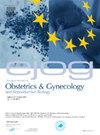妊娠期疑似肾绞痛干预后的新生儿预后。
IF 2.1
4区 医学
Q2 OBSTETRICS & GYNECOLOGY
European journal of obstetrics, gynecology, and reproductive biology
Pub Date : 2024-10-18
DOI:10.1016/j.ejogrb.2024.10.026
引用次数: 0
摘要
目的比较疑似肾绞痛孕妇接受尿路造影术、支架术或 PCN 术后的新生儿预后:回顾性分析 2008 年至 2022 年间在一家大型多中心医疗机构接受疑似肾绞痛手术的妊娠期妇女,并按初始干预进行分类。记录新生儿结局,并将其与产妇和产科数据联系起来。组间比较采用Kruskal-Wallis、方差分析或费雪精确检验,然后酌情进行配对后检验(α = 0.05)。此外还进行了多变量分析:95名患者接受了分析,其中32人接受了PCN治疗,47人接受了支架治疗,16人接受了URS治疗。各组产妇的基线特征相似,只是支架组的孕周和胎次较低。早产率没有差异,但 PCN 组的分娩胎龄低于支架组和 URS 组(分别为 p = 0.006 和 p = 0.025)。PCN 组的新生儿重症监护室(NICU)入院率高于支架组和 URS 组(分别为 p = 0.006 和 0.036)。各组之间的呼吸窘迫综合征差异明显(p = 0.041)。新生儿出生体重、Apgar评分和其他并发症无明显差异:本研究表明,与支架和 URS 相比,使用 PCN 管理的母亲所生的新生儿入住新生儿重症监护室的比例更高,胎龄更小。有必要进行更大规模的多机构研究,以进一步探讨这些关联。本文章由计算机程序翻译,如有差异,请以英文原文为准。
Neonatal outcomes after intervention for suspected renal colic in pregnancy
Objective
To compare neonatal outcomes following URS, stent, or PCN in pregnant women presenting with suspected renal colic.
Methods
Women undergoing a procedure for suspected renal colic during pregnancy at a large multi-center institution between 2008 and 2022 were retrospectively reviewed and categorized by initial intervention. Neonatal outcomes were recorded and linked to maternal and obstetric data. Groups were compared by a Kruskal-Wallis, ANOVA, or Fisher’s Exact test, followed by pairwise post-hoc testing as appropriate (α = 0.05). Multivariate analyses were also conducted.
Results
95 patients were analyzed, of whom 32 were managed with PCN, 47 with stent, and 16 with URS. Maternal baseline characteristics were similar between groups, except for lower gravidity and parity in the stent group. Rates of premature delivery did not differ, but gestational age at delivery was lower in the PCN group versus the stent and URS groups (p = 0.006 and p = 0.025, respectively). Neonatal Intensive Care Unit (NICU) admission rates were higher in the PCN group versus the stent and URS groups (p = 0.006 and 0.036, respectively). Respiratory distress syndrome significantly differed between groups (p = 0.041). Neonatal birth weight, Apgar scores, and other complications did not significantly differ.
Conclusion
This study demonstrated higher rates of NICU admissions and lower gestational age at delivery for neonates born to mothers managed with PCN compared to stent and URS. Larger multi-institutional studies are warranted to further explore these associations.
求助全文
通过发布文献求助,成功后即可免费获取论文全文。
去求助
来源期刊
CiteScore
4.60
自引率
3.80%
发文量
898
审稿时长
8.3 weeks
期刊介绍:
The European Journal of Obstetrics & Gynecology and Reproductive Biology is the leading general clinical journal covering the continent. It publishes peer reviewed original research articles, as well as a wide range of news, book reviews, biographical, historical and educational articles and a lively correspondence section. Fields covered include obstetrics, prenatal diagnosis, maternal-fetal medicine, perinatology, general gynecology, gynecologic oncology, uro-gynecology, reproductive medicine, infertility, reproductive endocrinology, sexual medicine and reproductive ethics. The European Journal of Obstetrics & Gynecology and Reproductive Biology provides a forum for scientific and clinical professional communication in obstetrics and gynecology throughout Europe and the world.

 求助内容:
求助内容: 应助结果提醒方式:
应助结果提醒方式:


